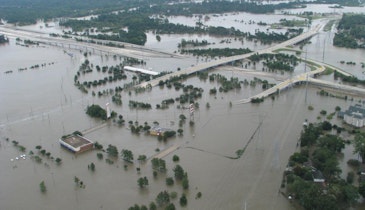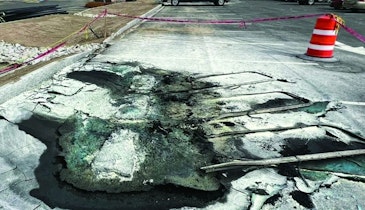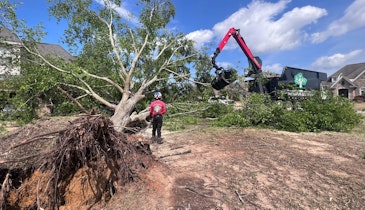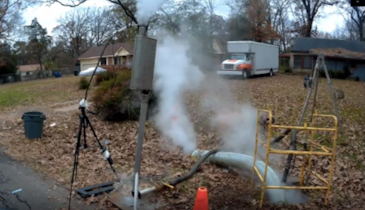
The Craven County Water Plant team maintained service to customers all through Hurricane Florence. From left are Elliot Thomas, Nadyne Bentley, Mindy Eddins and Samantha “Sam” Robbins.
Interested in Water?
Get Water articles, news and videos right in your inbox! Sign up now.
Water + Get AlertsHurricane Florence hit the North Carolina coast on Sept. 13, 2018, as a Category 1 storm, bringing a strong storm surge and torrential rains.
Water and wastewater plants throughout the Carolinas had about a week’s warning that the storm was on the way. They followed disaster plans to prepare for the storm and undertake recovery afterward. Among them was the water department in Craven County, North Carolina, in the Neuse River about 15 miles inland.
There, Elliot Thomas, water treatment plant supervisor; Mindy Eddins and Nadyne Bentley, plant operators; and Samantha Robbins, lead field technician, worked together to keep water flowing to some 14,000 customers, spread across the county’s rural areas and served by about 750 miles of waterlines.
Thanks to emergency generators, the water plant and the wells that feed it remained in operation throughout. The 3 mgd reverse osmosis membrane treatment plant (H2O Innovation) used its excess capacity to help a neighboring county and town when their systems were compromised by mains that washed out from flooding and broke.
Good preparation and around-the-clock efforts after the storm made it all possible. Thomas talked about the county’s experience in an interview.
Question: Why did Craven County build an RO water treatment plant?
Thomas: We were drawing from the Black Creek Aquifer, where all we had to do was add a little bit of chlorine for disinfection. But the Central Coastal Plains Capacity Use Area was trying to reduce the amount of water pulled out of that aquifer. Now we are in the Lower Castle Hayne Aquifer, and that water requires more treatment. It has a fairly high iron content and a little bit of manganese, and it’s very hard. Membrane technology enables us to produce water of very similar quality to the Black Creek water.
Question: What are your water plant team’s responsibilities?
Thomas: We take care of the water plant and the wellfields, including the Black Creek wells, in the western part of the county around Cove City. We handle general maintenance, the daily readings, and water sampling and analysis. We also deal with pressure problems and customer complaints about taste and odor. We also have a field technician staff of five employees.
Question: How much warning did you have that the storm was approaching?
Thomas: The storm hit on Thursday, and on the previous Thursday the county administration called a meeting of department heads and supervisors to discuss emergency plans.
Question: What did your team need to do in advance of the storm?
Thomas: Our first priority was to make sure all our emergency generators were topped off with fuel and to make sure we had enough chemicals to last through the storm. Next was to be sure that anything loose around the water plant was secured down. A composite sampler had to be moved inside. A calcite conveyance system had to be secured, and the generator doors needed to be closed and locked so the wind couldn’t blow them open and put rain on the electrical components. We also had to plan who needed to stay at the plant through the storm and what our duties would be once it passed.
Question: What emergency generators do you have?
Thomas: At the water plant we have a 1,500 kW generator (Cummins Power Products). Each of the wells that feed the water plant has an 80 kW generator (Cummins Power Products). The three wells in Cove City have 200 to 220 kW generators (two Detroit and one Caterpillar Inc., Electric Power Division). The booster pump stations have Kohler Power Systems generators rated at 40, 50 and 60 kW.
Question: What was the diesel fuel storage situation at the plant?
Thomas: The water plant has an 8,000-gallon fuel tank. If we’re running just to feed our customers, we can get 12 days out of it. If we have to produce more water because of losses or to help another utility, that may go down to seven or eight days.
Question: What happened while the storm made landfall and was at its most intense?
Thomas: Nadyne, Mindy and I stayed at the plant. At about 9:30 that night we lost communication to the tower that controls the pumps that push water out into the system, so we had to run those manually instead of by remote control. We never let the plant shut down. I threw the breaker to emergency power because the RO system has safeguards so that in the event of a power flicker the treatment process shuts down for 15 to 20 minutes. By going to emergency power, we avoided having a shutdown every time we got a power flicker.
Question: How long did the intense part of the storm last?
Thomas: It got bad at about 7 or 8 that Thursday night. We still had hurricane-force winds until 8 or 9 the next morning, and tropical-force winds into Saturday morning. It was a slow, slow-moving storm. We had some gusts measured at 110 to 120 mph. We got roughly 15 inches of rain here and maybe 20 to 25 inches around Cove City.
Question: What had to be done in the immediate aftermath of the storm?
Thomas: Right after the storm, we were losing about 200 gpm from leaks. Most were in private services where trees were uprooted in people’s yards and broke the pipes in two. We were fairly busy running around turning those services off so we didn’t lose so much water. We did have a leak in one of our 2-inch lines from a tree uprooting where we were losing about 50 gpm. We got that fixed quickly.
Question: How long did the system have to function on generator power?
Thomas: At the water plant, we were on the generator for one week solid. The main well sites that feed the plant were on emergency power for about five days, and the wells out in Cove City were on generators for three or four days. Those wells are in a big farming community, and there’s a farmer not far from one of our wells who we have an agreement with, where if we need fuel, he will provide it to us. Then we refuel his tanks with the amount we used.
Question: Did down trees or other obstacles get in the way of delivering generator fuel?
Thomas: It’s about 30 miles from the water plant to the wells in Cove City. The highway had probably a dozen trees across it that Friday morning, but by that afternoon, the DOT or the fire and emergency services had gotten the trees out of the way. The road to the water treatment plant had a couple of trees on it. We had a couple of chain saws here just in case, but by the time I ventured out on Friday morning, a couple of the residents had already cut the trees up, so we were able to get out without any burden.
Question: Was flooding an issue during or after the storm?
Thomas: The storm surge was one of the highest since Hurricane Hazel in the 1950s. It inundated a couple of things of ours that we were no longer using or not using at the time. The water plant elevation is roughly 25 to 27 feet. We’d probably have to see a 30-foot storm surge in order to flood us. The storm surge this time was 10 to 12 feet.
Question: What impact did the heavy rains have on local flooding?
Thomas: Two to three days after the storm is when the Neuse River here started cresting. It came close to what Hurricane Floyd did in the 1990s. We had one bridge go under and we had roads near the river that were becoming flooded, so we were not able to get to certain parts of the county but the integrity of water system was not compromised.
Question: What kept your team busy after the storm?
Thomas: Mostly it was keeping the generators fueled and assisting customers who had leaks.
Samantha was out helping customers who had their waterlines torn out of the ground by uprooted trees. She also helped keep the generators at our wells in Cove City topped off with fuel. We had some emergencies. A dog rescue site needed a place to house animals. They decided to use an old animal hospital that had shut down a year or so ago. It didn’t have any water because the service had been disconnected, so we got the water reconnected for them. It felt good to be able to help them out.
Question: Were neighboring water systems affected by the storm?
Thomas: I received a call from Jones County where they had issues with some waterline washouts. They asked if we could support them. We have an interconnect with them, and we were able to help them restabilize their water system. The following Monday, the town of Havelock had a washout and called for assistance; we were able to supply half of their town.
Question: What is the history behind those water system interconnects?
Thomas: It’s a good idea to have interconnects where neighboring systems have waterlines close to each other. It can work both ways. There have been times when Jones County has helped us out. Havelock has the ability to help us. We have interconnects with almost every water system that we are close to.
Question: When did you and your team get to go home?
Thomas: I was here a week. I went home once we got utility power back to the water plant. Nadyne was here a week; Mindy was here four days continuously.
This article was originally posted March 2019.





